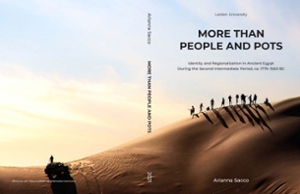Dissertation
More than people and pots: identity and regionalization in Ancient Egypt during the second intermediate period, ca. 1775-1550 BC
On the 23rd of June Arianna Sacco successfully defended a doctoral thesis and graduated.
- Author
- A. Sacco
- Date
- 23 June 2021
- Links
- Leiden Repository

During the Second Intermediate Period (ca. 1775-1550 BC) period, Egypt was politically and culturally divided into regions, and it was characterized by the presence of groups from modern-day Syria-Palestine and Sudan. To better understand the relationships between the Egyptian sites during this period, I have analysed the objects (beads, stone vessels, scarabs and seals, metal weapons, and two particular types of pottery) that the relevant sites have in common, through network analysis. This quantitative and statistical methodology, which makes use of digital tools, is ideal to examine the relations, as well as the flow and circulation of objects, resources, information, or knowledge between different entities, based on what these entities have in common (or not). During the Second Intermediate Period, contacts can still be detected between different areas, even though they were weaker and happened mostly through desert routes. Two phenomena can be detected: the growing importance of Tell el-Dab’a/Avaris in circulation of objects and resources, and the role played by the communities of Pan-grave culture, known only form archaeological remains and featuring connections with Nubia (modern-day Sudan).
Supervisor: prof. dr. O.E. Kaper.
